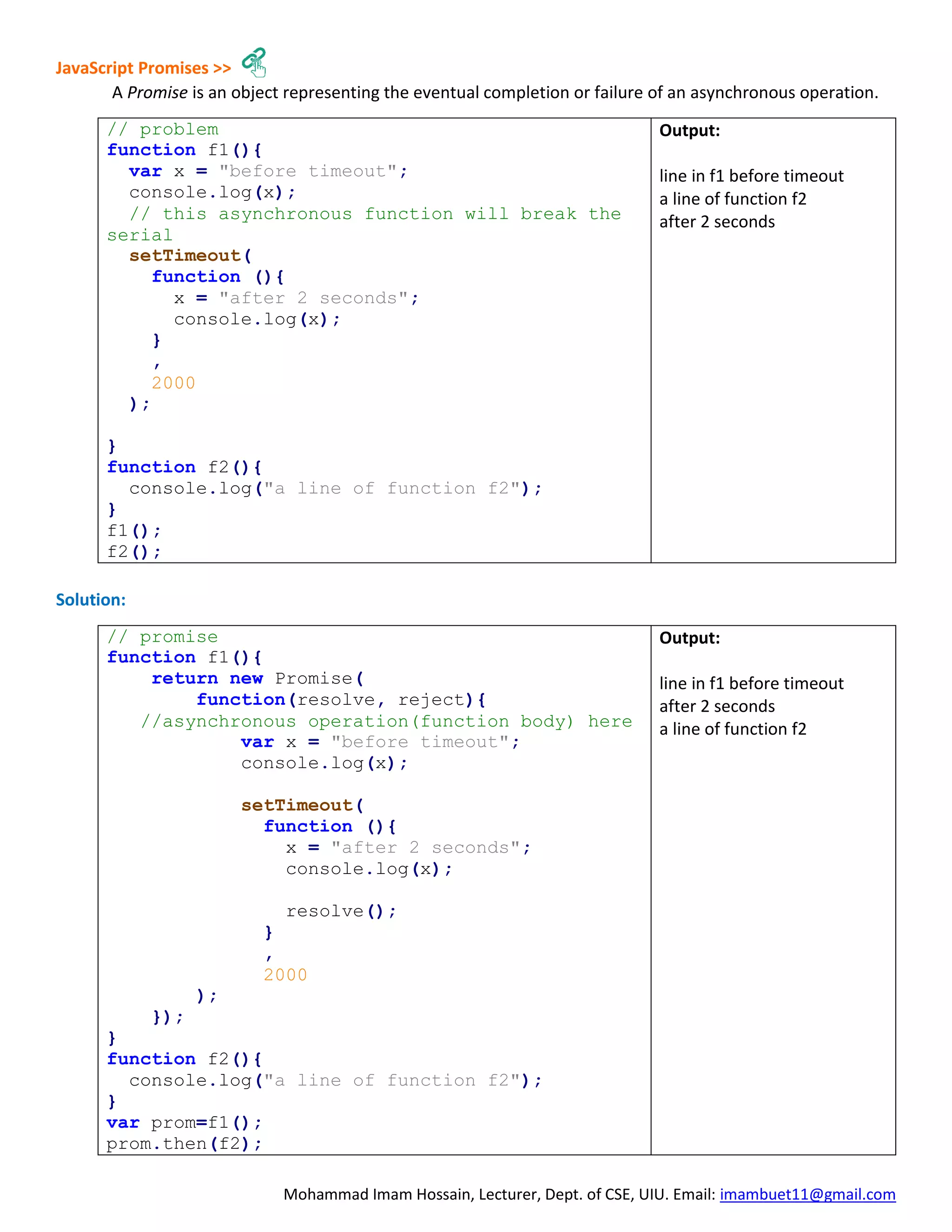The document provides an extensive overview of JavaScript, detailing its nature as a cross-platform, object-oriented scripting language used for enhancing web interactivity. It covers aspects such as client-side and server-side JavaScript, variable declarations, control flow, functions, and various built-in objects like Math and Date. Additionally, it explains the syntax and usage of features like hoisting, closures, and string manipulation methods.
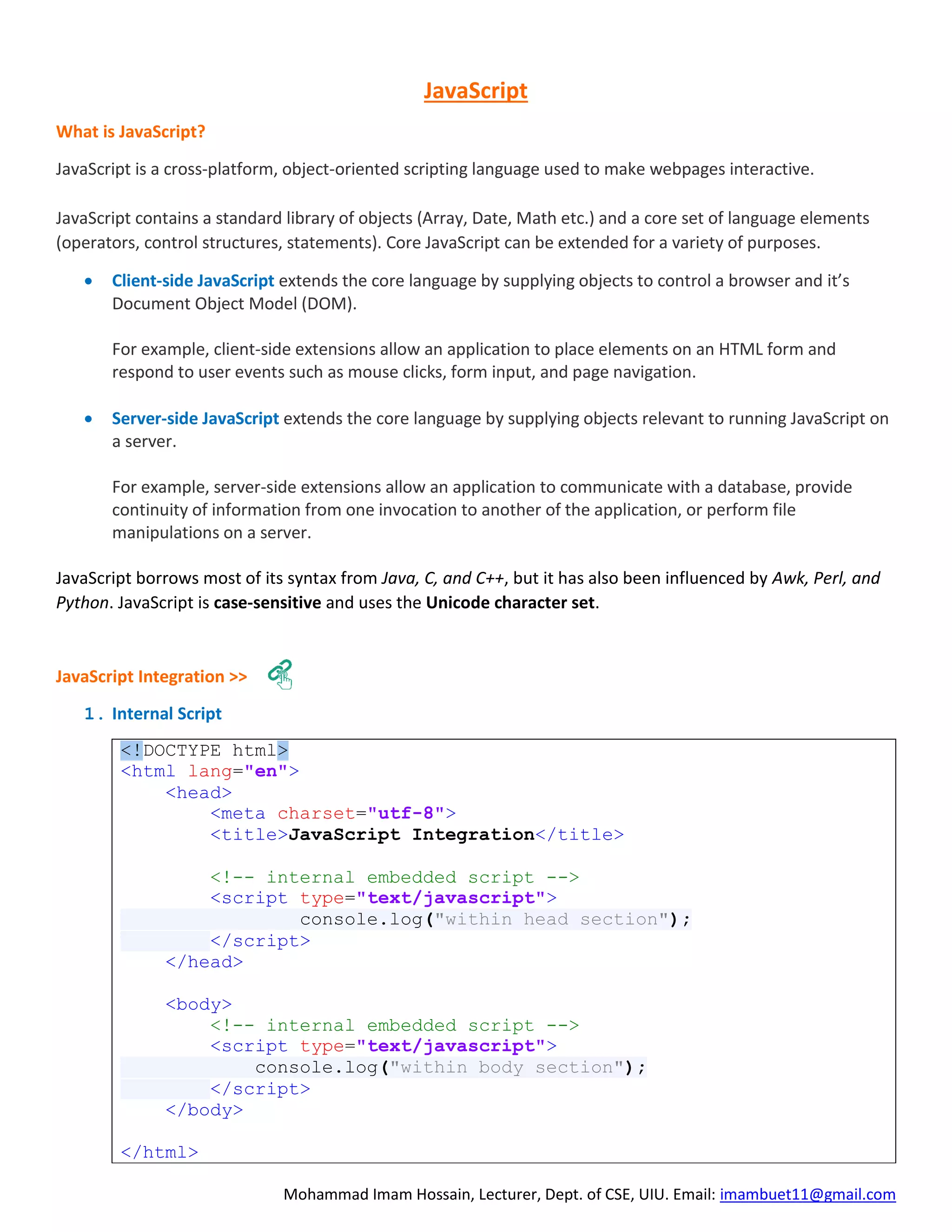
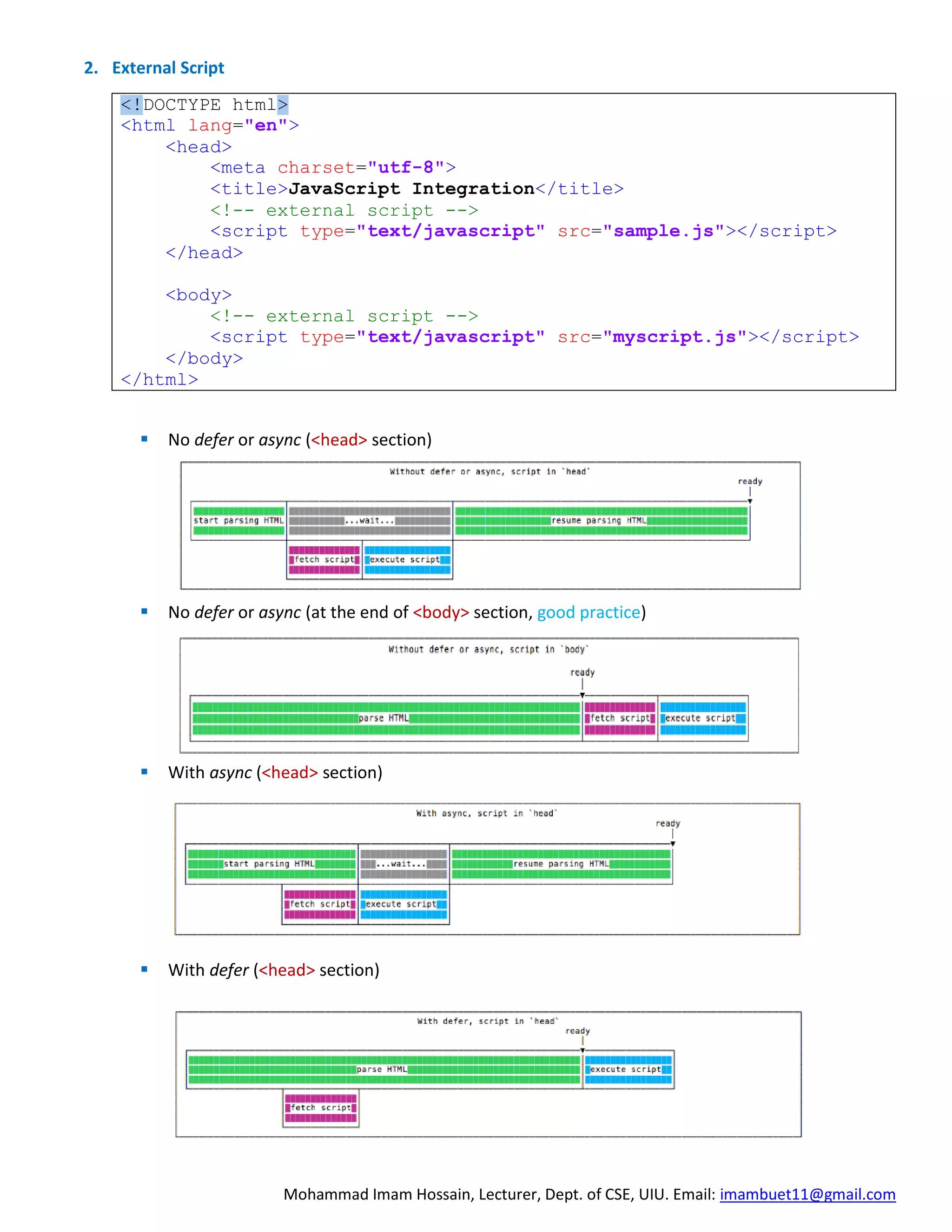
![Mohammad Imam Hossain, Lecturer, Dept. of CSE, UIU. Email: imambuet11@gmail.com Comments >> <script type="text/javascript"> // a one line comment /* this is a longer, * multi-line comment */ /* You can't, however, /* nest comments */ SyntaxError */ </script> Variable declarations >> var x = 42 – declares both function-scoped and globally-scoped variable depending on the execution context, optionally initializing it to a value. [ Default value is undefined ] Duplicate variable declarations using var will not trigger an error, even in strict mode, and the variable will not lose its value, unless another assignment is performed. var declarations gets hoisted. let v=42 – declares a block-scoped local variable, optionally initializing it to a value. Variables declared by let have their scope in the block for which they are defined, as well as in any contained sub-blocks. Duplicate variable declarations using let raises a SyntaxError. let declarations does not get hoisted. function varTest() { var x = 1; { var x = 2; // same variable! console.log(x); // 2 } console.log(x); // 2 } function letTest() { let x = 1; { let x = 2; // different variable console.log(x); // 2 } console.log(x); // 1 } const PI=3.14 – declares a block-scoped read-only named constant. You must specify its value in the same statement in which it is declared. Variable Hoisting >> In JavaScript, you can refer to a variable declared (using var) later, without getting an exception. This concept is known as hoisting; variables in JavaScript are in a sense "hoisted" or lifted to the top of the function or statement. However, variables that are hoisted return a value of undefined function do_something() { console.log(bar); // undefined var bar = 111; console.log(bar); // 111 } function do_something() { var bar; console.log(bar); // undefined bar = 111; console.log(bar); // 111 }](https://image.slidesharecdn.com/jsbasicsupdated-200808212352/75/Web-4-Core-JavaScript-3-2048.jpg)
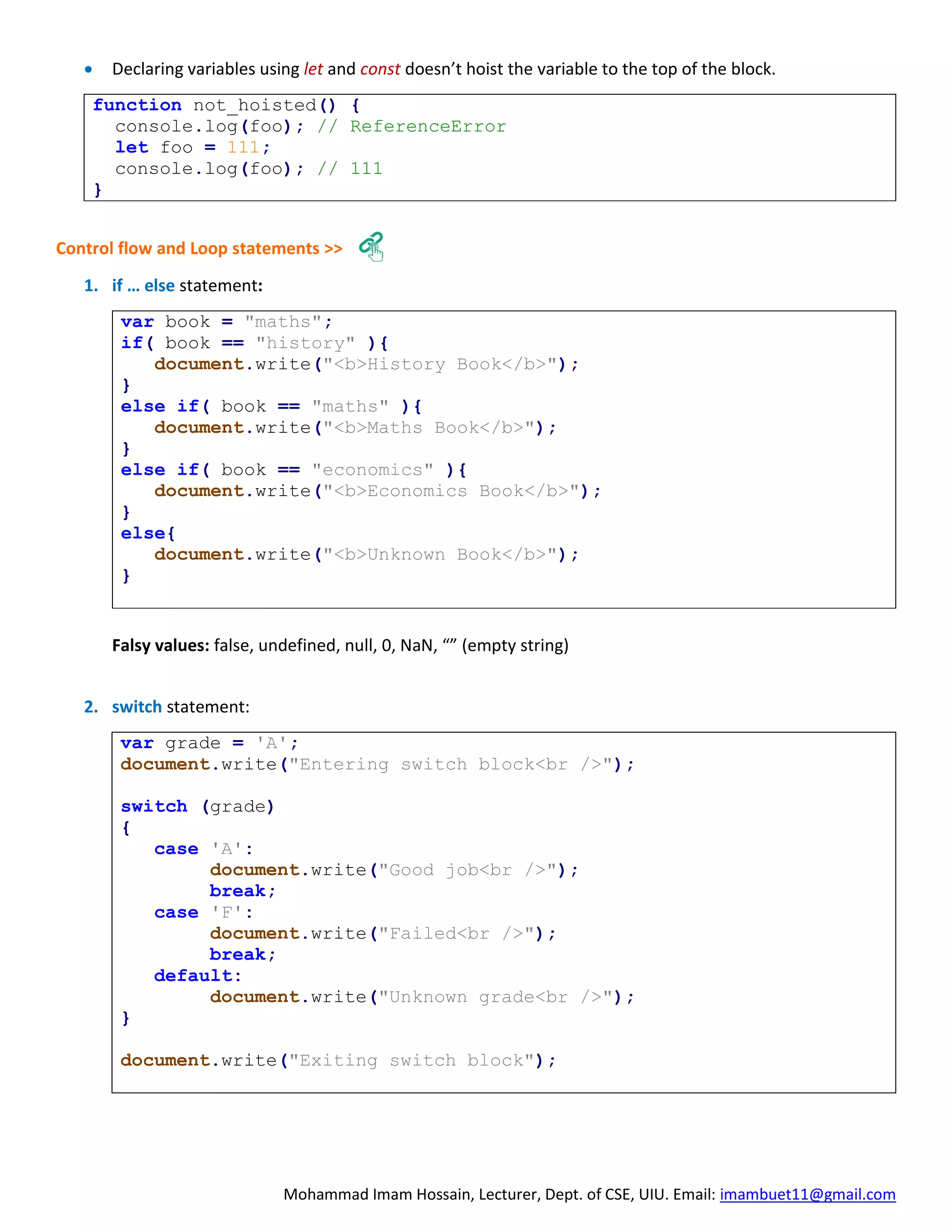
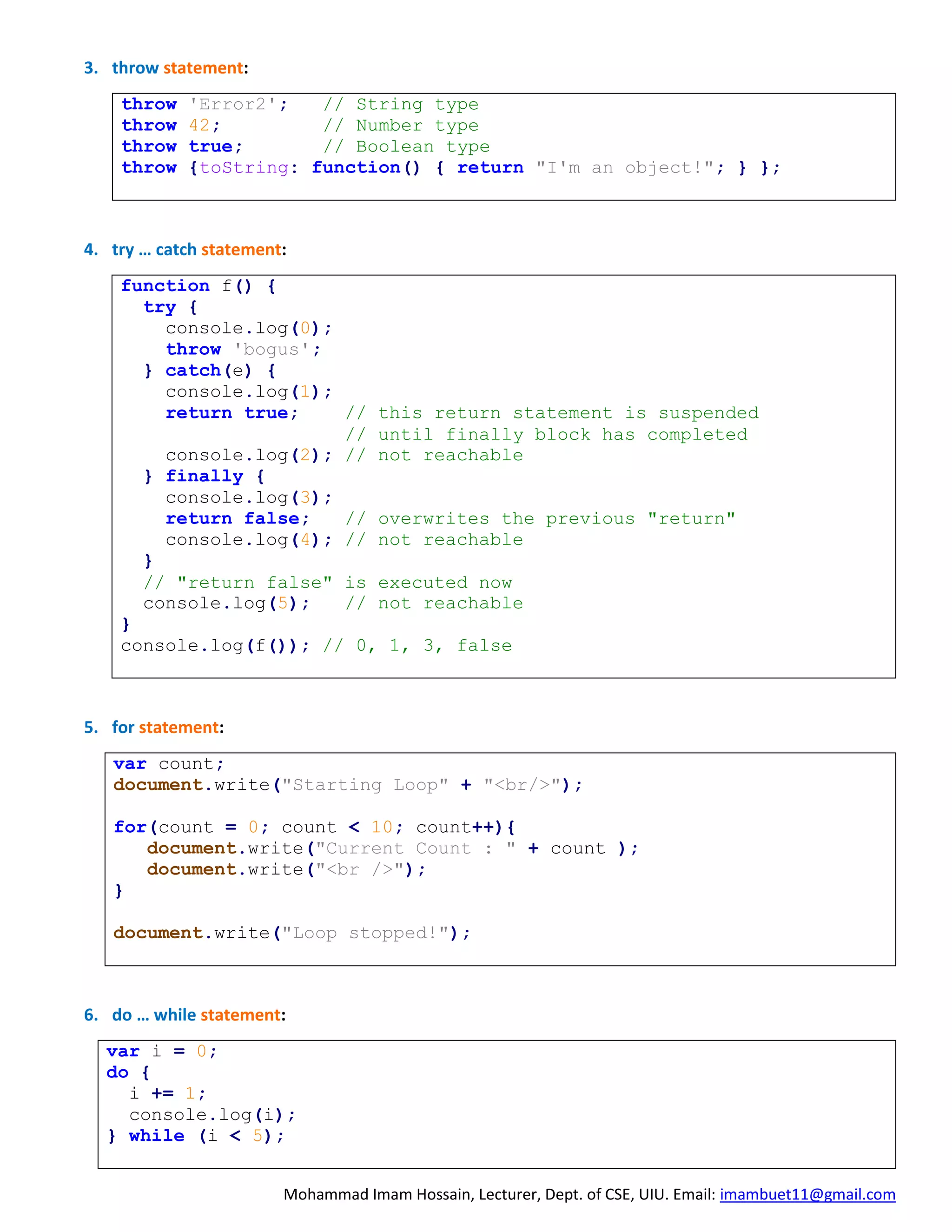
![Mohammad Imam Hossain, Lecturer, Dept. of CSE, UIU. Email: imambuet11@gmail.com 7. while statement: var n = 0; var x = 0; while (n < 3) { n++; x += n; } 8. break statement: var x = 1; document.write("Entering the loop<br/>"); while (x < 20) { if (x == 5){ break; // breaks out of loop completely } x = x + 1; document.write( x + "<br />"); } document.write("Exiting the loop!<br /> "); 9. continue statement: var i = 0; var n = 0; while (i < 5) { i++; if (i == 3) { continue; } n += i; console.log(n); } //1,3,7,12 10. for … in statement: var arr=['item0','item1','item2']; for(let ind in arr){ console.log(ind+" => "+arr[ind]); ///iterates over property names }](https://image.slidesharecdn.com/jsbasicsupdated-200808212352/75/Web-4-Core-JavaScript-6-2048.jpg)
![Mohammad Imam Hossain, Lecturer, Dept. of CSE, UIU. Email: imambuet11@gmail.com Functions >> 1. Function Declaration / Statement function fnname(param1, param2, param3, ... ){ // processing return return_value; } primitive parameters(ex. numbers) are passed to functions by value. non-primitive parameters (ex. array, objects) are passed by reference. 2. Function Expressions This type of function can be anonymous and can’t be hoisted. This type is convenient when passing a function as an argument to another function. function multiplier_factory(multiplier){ var fnexpr = function (value){ return multiplier*value; }; return fnexpr; } var _3multiplier = multiplier_factory(3); console.log(_3multiplier); console.log(_3multiplier(8)); 3. Immediately Invokable Function Expression (IIFE) – runs as soon as it is defined var param=100; (function (p1){ var privatevar='abcd'; console.log(p1); // 100 console.log(privatevar); // abcd })(param); console.log(privatevar); //ReferenceError-can't access this variable 4. Arrow function var a = ['Hydrogen','Helium','Lithium','Beryllium']; var a2 = a.map(function(s) { return s.length; }); console.log(a2); // logs [8, 6, 7, 9] var a3 = a.map(s => s.length); console.log(a3); // logs [8, 6, 7, 9]](https://image.slidesharecdn.com/jsbasicsupdated-200808212352/75/Web-4-Core-JavaScript-7-2048.jpg)
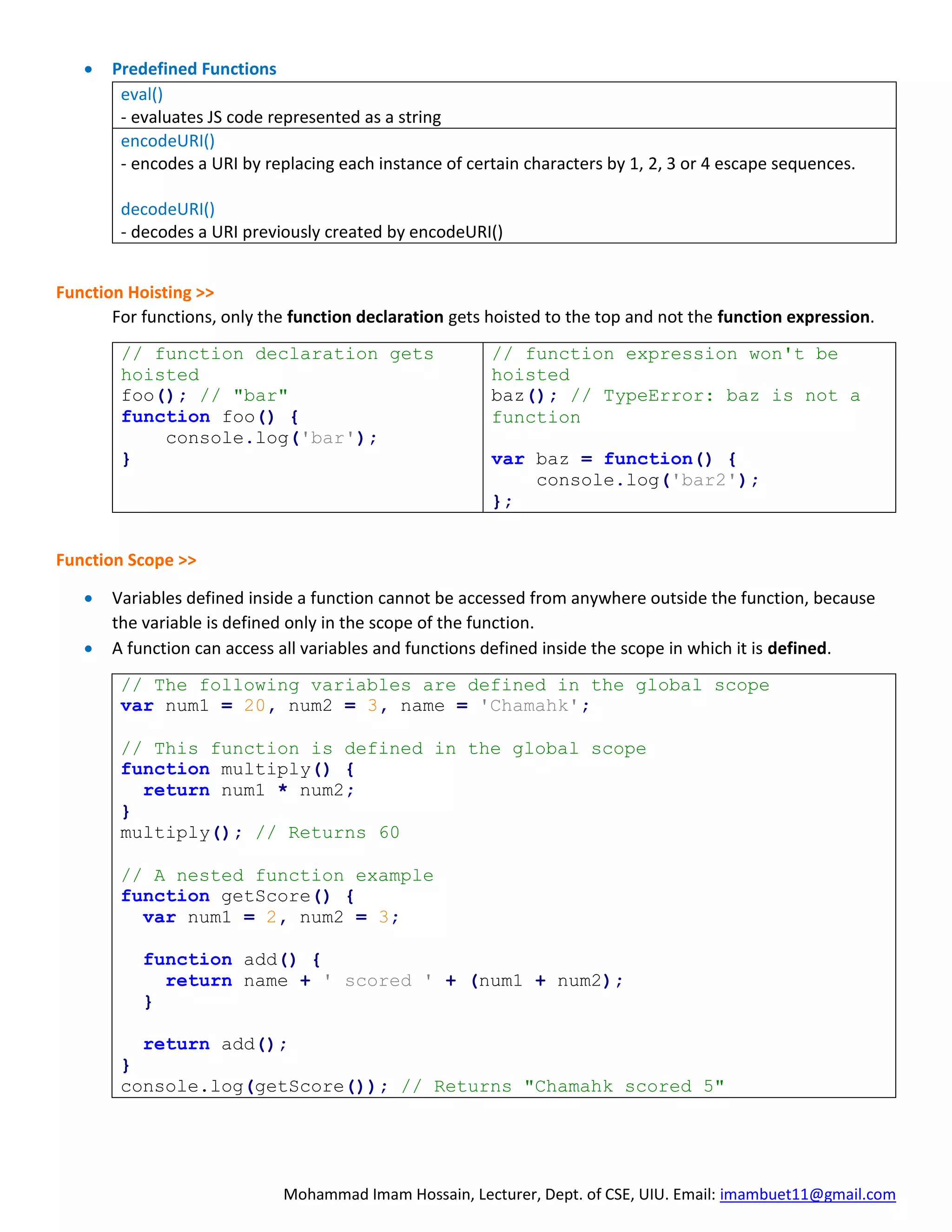
![Mohammad Imam Hossain, Lecturer, Dept. of CSE, UIU. Email: imambuet11@gmail.com Nested Function >> You can nest a function within another function. The nested (inner) function is private to its containing (outer) function. The inner function forms a closure: the inner function can use the arguments and variables of the outer function, while the outer function cannot use the arguments and variables of the inner function. - A closure is an expression that can have free variables together with an environment that binds those variables. We can say that inner functions contains the scope of the outer function. function A(x) { function B(y) { function C(z) { console.log(x + y + z); } C(3); } B(2); } A(1); // logs 6 (1 + 2 + 3) here, - B forms a closure including A (i.e. B can access A’s arguments and variables) - C forms a closure including B. - Because B’s closure includes A, C’s closure includes A, C can access both B and A’s arguments and variables. argument Object >> The arguments of a function are maintained in an array-like object. Within a function, you can address the arguments passed to it by accessing an array named arguments function myConcat(separator) { var result = ''; // initialize list var i; // iterate through arguments for (i = 1; i < arguments.length; i++) { result += arguments[i] + separator; } return result; } // returns "red, orange, blue, " console.log(myConcat(', ', 'red', 'orange', 'blue')); Default Parameters >> function multiply(a, b = 1) { return a * b; } console.log(multiply(5)); // 5](https://image.slidesharecdn.com/jsbasicsupdated-200808212352/75/Web-4-Core-JavaScript-9-2048.jpg)
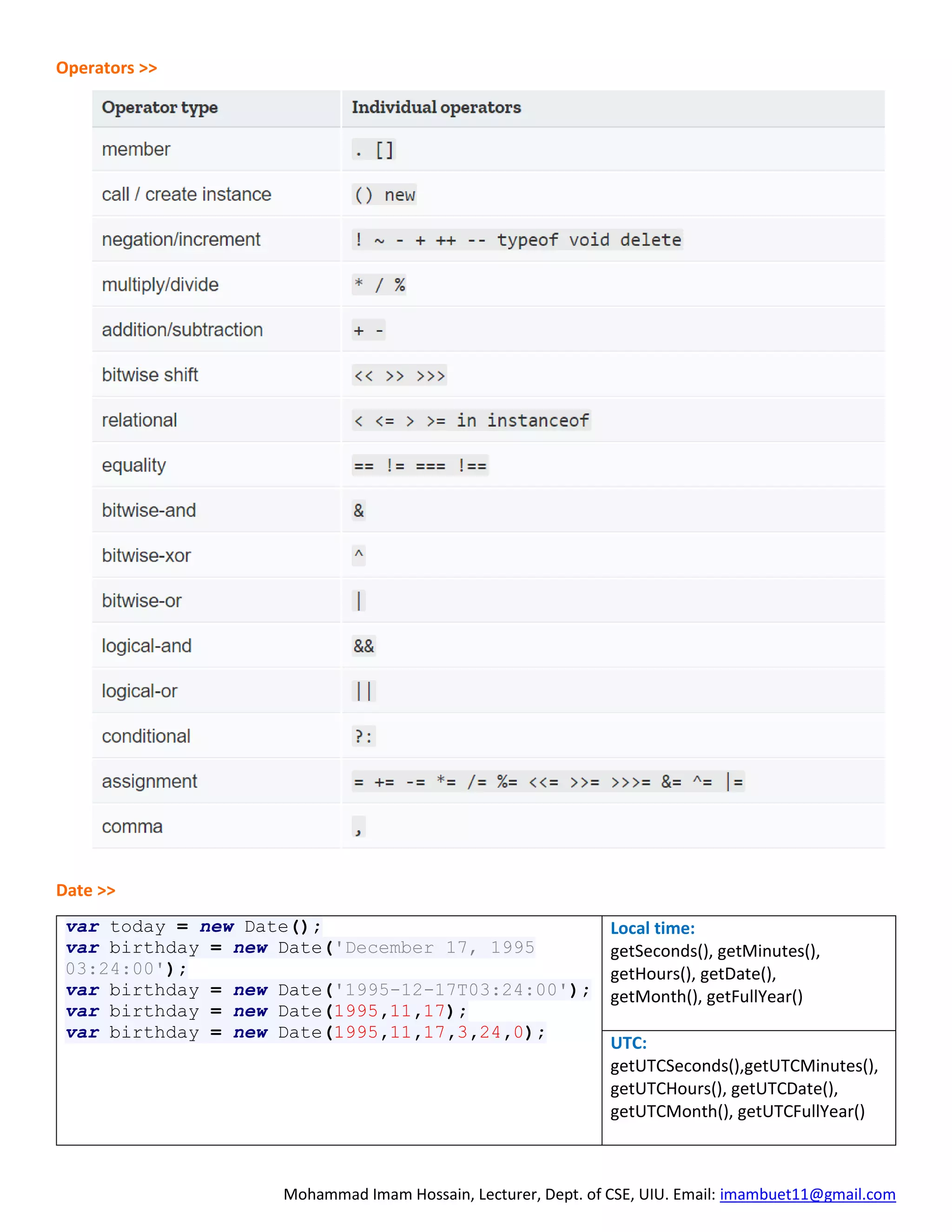
![Mohammad Imam Hossain, Lecturer, Dept. of CSE, UIU. Email: imambuet11@gmail.com Number >> literals dec: 42, 0888(strict) oct: 0777(non-strict), 0o777 bin: 0b0101, 0B1101 hex: 0x12A, 0XAF9 exp: 1E3, 2e6 let int = 42; let oct = 077; let hex = 0xFF; let bin = 0b1011; let exp = 2e4; console.log(int+" "+oct+" "+hex+" "+bin+" "+exp); // output: 42 63 255 11 20000 Number Object constructor: const a = new Number(‘123’); properties: MAX_VALUE MIN_VALUE NaN NEGATIVE_INFINITY POSITIVE_INFINITY methods: parseFloat(str) parseInt(str) isInteger() isNaN() const mystr = '123.456'; let mynum = undefined/10; console.log(Number.parseFloat(mystr)); console.log(Number.parseInt(mystr)); console.log(Number.isNaN(mynum)); Math Object properties: PI E methods: random() abs(x) ceil(x), floor(x), round(x), trunc(x) sqrt(x), pow(x, y), exp(x) log(x), log10(x), log2(x) sin(x), cos(x), tan(x) max(x, y, z, … ), min(x, y, z, … ) // degree to radian conversion function degToRad(deg){ return deg*(Math.PI/180); } console.log(degToRad(30)); //generating random numbers with range [min, max] function randomGenerator(min, max){ return Math.floor(Math.random()*(max-min+1)) +min; } console.log(randomGenerator(3,8));](https://image.slidesharecdn.com/jsbasicsupdated-200808212352/75/Web-4-Core-JavaScript-11-2048.jpg)
![Mohammad Imam Hossain, Lecturer, Dept. of CSE, UIU. Email: imambuet11@gmail.com String >> JavaScript's String type is used to represent textual data. It is a set of "elements" of 16-bit unsigned integer values (UTF-16 code units). Each element in the String occupies a position in the String. The first element is at index 0, the next at index 1, and so on. 1. Creating Strings // creating strings const str1 = 'string literal'; const str2 = "string literal"; const str3 = new String('string object'); // JavaScript automatically converts the string literal to a temporary String object, calls the method, then discards the temporary String object. console.log(str1); // literal console.log(str2); // literal console.log(str3); // object 2. String Object property – length // String Object property - length const hello = 'Hello, World!'; const helloLength = hello.length; // length: 13 hello[0] = 'L'; // This has no effect, because strings are immutable console.log(hello[0]); // This returns "H" 3. String Object methods Method Name Return Value Sample Code toLowerCase() toUpperCase() - lowercase string - uppercase string const mystr1 = 'AbCd'; console.log(mystr1.toLowerCase()); // abcd console.log(mystr1.toUpperCase()); // ABCD indexOf(substr [,fromIndex]) lastIndexOf(substr [,fromIndex]) - index of the first occurrence or -1 if not found - index of the first occurrence from backward or -1 if not found // indexOf(substr[, fromIndex]) and lastIndexOf(substr[, fromIndex]) const mystr2 = 'abcdxyzabcd'; console.log(mystr2.indexOf('abcd')); // 0 console.log(mystr2.lastIndexOf('abcd')); // 7 split(separator) - array of substrings // split(separator) const str = 'The quick brown fox jumps over the lazy dog.'; let splitarr = str.split(' '); console.log(splitarr);](https://image.slidesharecdn.com/jsbasicsupdated-200808212352/75/Web-4-Core-JavaScript-12-2048.jpg)
![Mohammad Imam Hossain, Lecturer, Dept. of CSE, UIU. Email: imambuet11@gmail.com slice(startInd [,uptoInd]) substring(startIn [,uptoInd]) substr(startInd [,length]) - new string - new string - new string // slice(startIndex[, uptoIndex]) , substring(startIndex[, uptoIndex]) and substr(startIndex[, length]) const mystr3 = 'abcdefghij'; console.log(mystr3.slice(1,3)); // bc console.log(mystr3.substring(1,3)); // bc console.log(mystr3.substr(1,2)); // bc + operator concat(str2, str3, … ) - concatenate two or more strings const mystr4 = "Hello"; const mystr5 ="world"; console.log(mystr4+" "+mystr5); console.log(mystr4.concat(" ", mystr5)); Other Methods: charAt(), charCodeAt() startsWith(), endsWith(), includes() trim() 4. Embedded expressions: const five = 5; const ten = 10; console.log('Fifteen is ' + (five + ten) + ' and not ' + (2 * five + ten) + '.'); // "Fifteen is 15 and not 20." console.log(`Fifteen is ${five + ten} and not ${2 * five + ten}.`); // use backtick template literal // "Fifteen is 15 and not 20." Regular Expression >> Declarations /* format: /patter/flag */ /* flag: i = case-insensitive, g = global etc. */ var re1 = /^[A-Za-z][A-Za-z_#-]*$/; var re2 = /^[A-Z]{2,5}$/i; // using RegExp class var re3 = new RegExp('[A-Za-z]{1,5}'); var re4 = new RegExp('[A-Za-z]{1,5}','i'); Regular Expression Syntax https://developer.mozilla.org/en- US/docs/Web/JavaScript/Guide/Regular_Expressions RegExp Object methods: exec(), test() var re2 = /^[A-Z]{2,5}$/i; var str = "abcd"; if(re2.test(str)){ console.log("match found"); } else{ console.log("no match found"); } String Object methods match(), matchAll(), search(), replace(), split()](https://image.slidesharecdn.com/jsbasicsupdated-200808212352/75/Web-4-Core-JavaScript-13-2048.jpg)
![Mohammad Imam Hossain, Lecturer, Dept. of CSE, UIU. Email: imambuet11@gmail.com Array >> An array is an ordered list of values that you refer to with a name and an index. Example, emp[0] JavaScript does not have an explicit array data type. However, you can use the predefined Array object and its methods to work with arrays in your applications. 1. Creating an Array // declarations let arr = new Array('item0','item1','item2'); let arr1 = Array('item0','item1','item2'); let arr2 = ['item0','item1','item2']; // an array with non-zero length, but without any items let len=10; let arr3=new Array(len); let arr4=Array(len); let arr5=[]; arr5.length=len; 2. Accessing Array elements // accessing array elements let myarray = ['item0', 'item1', 'item2']; console.log(arr[0]); console.log(arr[1]); console.log(arr[2]); 3. Populating an Array // populating an array let myarray1 = [] myarray1[0] = 'one'; myarray1[1] = 'two'; myarray1[2] = 'three'; 4. Array Object property - length // array object property - length let myarray2 = []; myarray2[30] = 'thirty'; console.log(myarray2.length); // 31](https://image.slidesharecdn.com/jsbasicsupdated-200808212352/75/Web-4-Core-JavaScript-14-2048.jpg)
![Mohammad Imam Hossain, Lecturer, Dept. of CSE, UIU. Email: imambuet11@gmail.com 5. Iterating over Arrays: // Iterating over Arrays let myarray3 = ['item0', 'item1', 'item2', 'item3']; myarray3[10] = 'item10'; // way 1 for(let ind=0;ind<myarray3.length;ind++){ console.log(ind+" => "+myarray3[ind]); } // way 2 - it is not advisable to iterate through JavaScript arrays using for...in loops, because normal elements and all enumerable properties will be listed. for(let ind in myarray3){ console.log(ind+" => "+myarray3[ind]); } 6. Array Object methods Method Name Return Value Sample Code concat(e1, e2, … ) new array let myArray = new Array('1', '2', '3'); myArray = myArray.concat('a', 'b', 'c'); console.log(myArray); // myArray is now ["1", "2", "3", "a", "b", "c"] join(delimeter = ’,’) string let myArray1 = new Array('Wind', 'Rain', 'Fire'); let list = myArray1.join(' - '); console.log(list); // list is "Wind - Rain - Fire" push(e1, e2, … ) pop() - length of the array - last element that is popped let myArray2 = new Array('1', '2'); myArray2.push('3', '4'); console.log(myArray2); // myArray2 is now ["1", "2", "3", "4"] let last = myArray2.pop(); console.log(myArray2); console.log(last); // myArray2 is now ["1","2","3"],last="4" unshift(e1, e2, … ) shift() - length of the array - first element that is removed let myArray3 = new Array('1', '2', '3'); myArray3.unshift('4', '5'); console.log(myArray3); // myArray3 becomes ["4","5","1","2","3"] let first = myArray3.shift(); console.log(myArray3); console.log(first); // myArray3 is now ["5","1","2","3"], first is "4"](https://image.slidesharecdn.com/jsbasicsupdated-200808212352/75/Web-4-Core-JavaScript-15-2048.jpg)
![Mohammad Imam Hossain, Lecturer, Dept. of CSE, UIU. Email: imambuet11@gmail.com slice(start_ind, upto_ind) splice(ind, count_to_remove, addelm1, addelm2, … …) - new subarray - returns the removed items array // slice(start_index, upto_index) let myArray4 = new Array('a','b','c','d', 'e'); newArray = myArray4.slice(1, 4); console.log(newArray); // starts at index 1 and extracts all elements until index 3, returning [ "b", "c", "d"] // splice(index, count_to_remove, addelm1, addelm2, ...) let myArray5 = new Array('1','2','3','4', '5'); remArray = myArray5.splice(1,3,'a','b', 'c','d'); console.log(remArray); console.log(myArray5); // remArray is now ["2", "3", "4"] // myArray5 is now ["1","a","b","c","d", "5"] reverse() sort() / sort(sortFn) - reference to the array - reference to the array let myArray6 = new Array('1', '2', '3'); myArray6.reverse(); console.log(myArray6); // transposes the array so that myArray6 = ["3", "2", "1"] let myArray7 = new Array('Wind', 'Rain', 'Fire'); myArray7.sort(); console.log(myArray7); // sorts the array so that myArray7 = ["Fire", "Rain", "Wind"] indexOf(searchelm [, fromIndex]) lastIndexOf( searchelm [,fromIndex]) - index of the first match - index of the first match from backward let myArray9 = ['a', 'b', 'a', 'b', 'a']; console.log(myArray9.indexOf('b')); // output: 1 console.log(myArray9.lastIndexOf('b')); // output: 3 7. Manipulating Array elements forEach(callbackfn) - executes callbackfn on every array items and console.log the output let a = [1, 2, 3] a.forEach(function(element) { console.log(element+10); }) // logs each item in turn 11, 12, 13 map(callbackfn) - executes callbackfn on every array items and returns a new array containing the return values // map(callbackfn) let a1 = ['a', 'b', 'c'] let a2 = a1.map(function(item) { return item.toUpperCase(); }) console.log(a2) // logs ['A', 'B', 'C']](https://image.slidesharecdn.com/jsbasicsupdated-200808212352/75/Web-4-Core-JavaScript-16-2048.jpg)
![Mohammad Imam Hossain, Lecturer, Dept. of CSE, UIU. Email: imambuet11@gmail.com Other Methods: filter(callbackfn) – returns a new array containing items for which callbackfn returnd true. every(callbackfn) – returns true if callbackfn returns true for all elements of the array. some(callbackfn) – returns true of callbackfn returns true for at least one element of the array. reduce(callbackfn) – returns the final value returned by callbackfn. Objects >> JavaScript is designed on a simple object-based paradigm. An object is a collection of properties, and a property is an association between a name (or key) and a value. A property's value can be a function, in which case the property is known as a method. 1. Creating new Object Method 1 – Object Initializer var obj = { property_1: value_1, //property_# may be an identifier 2: value_2, // or a number... // ..., 'property n': value_n // or a string }; Example : var obj_literal={ key1: 'named key', 1: 'integer key', "key2": 'string key' }; for(let prop in obj_literal){ console.log(obj_literal[prop]); } Method 2 – Object Declaration var myCar = new Object(); myCar.make = 'Ford'; myCar.model = 'Mustang'; myCar.year = 1969; for(let prop in myCar){ console.log(myCar[prop]); }](https://image.slidesharecdn.com/jsbasicsupdated-200808212352/75/Web-4-Core-JavaScript-17-2048.jpg)
![Mohammad Imam Hossain, Lecturer, Dept. of CSE, UIU. Email: imambuet11@gmail.com Method 3 – Function Constructor function Car(make, model, year) { this.make = make; this.model = model; this.year = year; } var mycar = new Car('Eagle', 'Talon TSi', 1993); for(let prop in mycar){ console.log(mycar[prop]); } 2. Accessing Object properties: var myCar = new Object(); myCar.make = 'Ford'; myCar.model = 'Mustang'; myCar.year = 1969; console.log(myCar.model); var k='make'; console.log(myCar[k]); console.log(myCar['year']); 3. Defining methods var obj1 = { key1: function (p1=1, p2=1){ return p1*p2; }, key2: 100 }; console.log(obj1.key1(10,5)); // --------------------------------- var obj2 = new Object(); obj2.key1 = function (p1=1, p2=1){ return p1*p2; }; obj2.key2 = 100; console.log(obj2.key1(10,5)); // --------------------------------- function ObjectFn(k1, k2){ this.key1 = k1; this.key2 = k2; } function method(p1=1, p2=1){ return p1*p2; } var obj3 = new ObjectFn(method, 100); console.log(obj3.key1(10, 5));](https://image.slidesharecdn.com/jsbasicsupdated-200808212352/75/Web-4-Core-JavaScript-18-2048.jpg)
